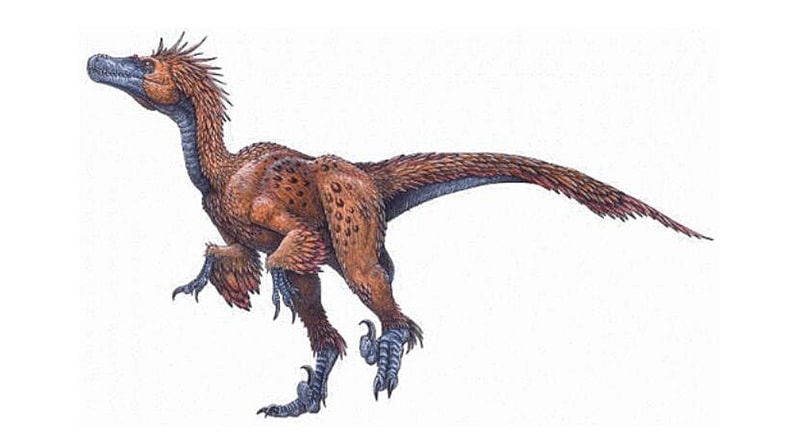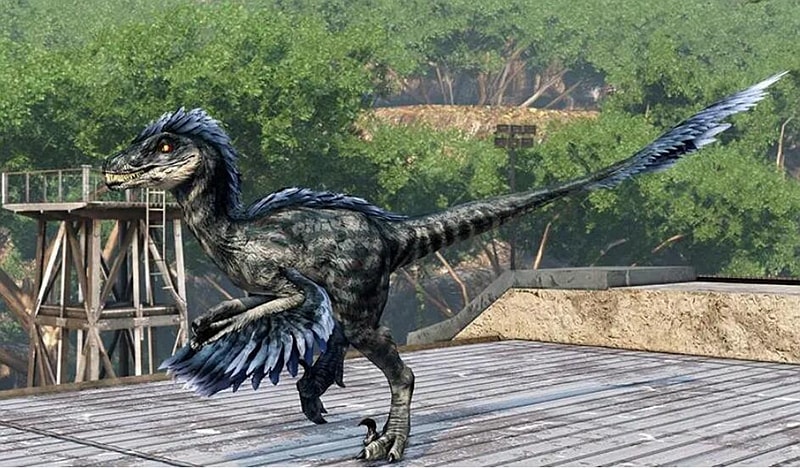Dinosaur Encyclopedia
Cretaceous Killer – Deinonychus
Deinonychus, just by its name, you can probably guess that this is a formidable dinosaur. Indeed, it has its “dragon” aspects. Let’s take a look together!
Dinosaur Knowledge Card:
- Family: Dromaeosauridae, Deinonychus genus
- Distribution: Montana and Wyoming, USA
- Time: Early Cretaceous, approximately 119 to 93 million years ago
- Length: Approximately 3.5 meters
- Weight: 20-30 kilograms
- Identifying Features: Enormous sickle-shaped claw on the hind limbs

>>Morphological Features:
Deinonychus is about 3.5 meters long and weighs around 20-30 kilograms. It has a powerful jaw with strong biting force. With nearly 60 curved and sharp teeth, it is a typical carnivorous dinosaur. Similar to the Velociraptor, It has large eyes, indicating well-developed eyesight, allowing it to spot prey from a distance. When walking, they exhibit an interesting behavior of lifting the second toe with scythe-like claws to avoid ground contact and wear.
>>Morphological Characteristics and Behavior:
Deinonychus inhabits flooded plains or swamps and prefers living in tree hollows. Due to its large claws, it sometimes nests on tree trunks.
Like other theropod dinosaurs, Deinonychus is a bipedal animal. Despite its relatively small size, It was one of the most ferocious carnivorous dinosaurs of the Early Cretaceous, known for its incredible speed and formidable predatory methods.

>>Deinonychus’ “Claws”:
The name Deinonychus is derived from ancient Greek, meaning “terrible claw.” Its claws are unique, featuring a keratin sheath on top and exceptional strength. The second toe of its hind feet has a large and strongly curved sickle-shaped claw, measuring up to 12 cm in length. When walking or running, the second toe is lifted upward, avoiding ground contact, and only the third and fourth toes bear its weight.
>>Secret to Rapid Running:
Deinonychus runs at a speed comparable to a swift wind, surpassing not only the Tyrannosaurus rex but also most other dinosaurs. The unique structure of its tail plays a significant role in this. Deinonychus’ tail is exceptionally rigid, composed of long rod-like bones and stiffened tendons. When it runs rapidly, the tail acts as both a propeller and a balancer, also providing the ability to make turns.
>>Exceptional Hunting Abilities:
Despite its small size, Deinonychus is agile and exceptionally fierce. Its forelimbs feature three long claws, and the wrists are more flexible than other carnivorous dinosaurs. The primary purpose of its forelimbs is to grasp the prey, immobilizing it, while the serrated dagger-like teeth in its mouth are used for biting. Combined with its “terrible claws,” It can triumphantly defeat its prey. Even when encountering dinosaurs several times its size, Deinonychus, using its formidable claws, can quickly subdue its opponent, making it a formidable predator. Its actions during hunting are agile and forceful, with the prey subdued before understanding what happened, earning Deinonychus the title of “terror killer.”
Paleontologists found that Deinonychus’ forelimbs resemble the hands of birds, but no evidence of feathers has been discovered. This discovery led to the hypothesis that birds evolved from dinosaurs, sparking debates on whether dinosaurs were warm-blooded. This shift in understanding is known as the Dinosaur Renaissance.
>>Speed:
Deinonychus has long been considered a fast runner in popular media, largely due to its ossified tail. When it runs quickly, this long tail acts as both a propeller and a balancer. However, some scientists argue that the relative lengths of the foot and shin bone determine an animal’s running speed, suggesting that Deinonychus’ running speed might be surprisingly low. In 1981, a scientist made a rough estimate of its walking speed based on footprints, suggesting a speed of 10.1 km/h while walking.
>>Fun Extension:
In the world of dinosaurs, many species share close relationships. For example, Deinonychus is closely related to Velociraptor. They both have large claws, with the first toe being the shortest among the three toes, while the second toe is the longest. The sickle-shaped claws on the second toe of each hind limb are remarkably long, creating a mismatch with their body length.